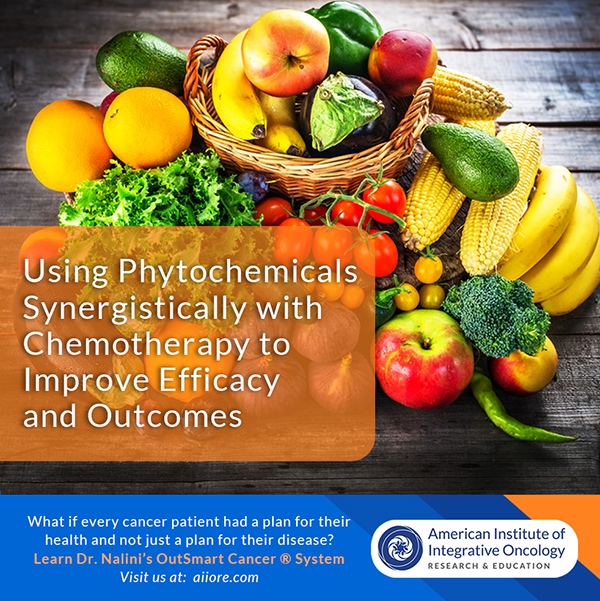The role of polyphenols in overcoming drug resistance.
In a paper published in January 2022, Maleki Dana et al, engage in a thorough review of multiple polyphenols which, when used concurrently with chemotherapy, can inhibit the development of chemo-resistance, rendering treatment more effective and for a longer duration of time.
Most oncologists are wary of negative drug-herb, drug nutrient interactions.
This review shows that we can use polyphenol phytochemicals synergistically with chemotherapy treatments to support efficacy and outcomes.
The Outsmart Cancer® System is an Integrative Cancer Care model seeking to develop highly individualized care plans that include the best therapeutic approaches and tools from multiple disciplines, combining a disease focused targeted pathology model with a whole biosystem health model to support the best outcomes for patients.
Acquired drug resistance has become a challenge that may result in treatment failure. Multiple factors contribute to chemo-resistance in cancer cells. Acquired drug resistance occurs when cancer cells fail to respond to a previously effective treatment. Intrinsic chemo-resistance occurs when a pre-existing factor causes a drug to be inefficient or ineffective.
Due to the inherent heterogeneity of tumors, subpopulations of cells may develop resistance while other subpopulations remain sensitive to treatment.
This is the rationale for using multiple agents which impact multiple signally pathways and receptors to target a wide array of heterogeneous cells. This is also the rationale for using multiple nutriceuticals, botanicals and phytochemicals concurrently to address multiple signaling pathways and functions.
In this excellent review paper the author focuses on the multiple synergistic functions of polyphenols citing multiple studies.
Polyphenols from medicinal plants and food plants form a large part of our Materia Medica. Polyphenols include several subclasses such as catechins, flavonoids, flavones, flavonols, anthocyanins, isoflavones, curcuminoids, chalcones and phenolic acids. These natural compounds are widely found found in deeply pigmented fruits, vegetables, cocoa, seeds and green and black teas,
Not only do polyphenols inhibit multiple pathways and mechanisms of drug resistance, but also act to confront many of the Hallmarks of Cancer, thus inhibiting and controlling the activity and viability of malignant cells.
The multiple functional roles of
- Resveratrol
- EGCG Epigallocatechin gallate
- Curcumin
are discussed and examined in depth examining multiple pathways, mechanisms of action and dosing.
Also discussed are additional well researched polyphenols, many of which are sourced from food plants as well as medicinal plants including
- Quercetin
- Baicalin
- Baicalien
- Apigenin
- Chrysin
- Luteolin
- Kaempferol
Mechanisms which lead to drug resistance in tumor cells
Malignant cells are highly adaptive and respond to toxic stressors such as chemotherapeutic drugs in the tumor micro-environment in service to their own survival. Essential malignant cells are “smart” and they can not only co-opt normal physiologic and metabolic functions within cells to respond to the presence of toxic drug therapies.
- Decreased Drug Uptake by tumor cells
- Drug Efflux from tumor cells (membrane pumps)
- Alterations in drug metabolism
- Epigenetic Modification and Signaling
- Inhibition of Programmed Cell death via apoptosis, autophagy and necrosis in tumor cells
- Alterations in DNA repair
- Activity of Cancer Stem Cells
- Redox Capacity of cells in response to oxidative stress
- Alterations in Epithelial to Mesenchymal Transition, Invasion and Metastatic Progression
Not only are polyphenols capable of addressing the common Hallmarks of Cancer, but they can also inhibit the multiple ways that malignant cells seek to survive in the face of drug therapies.
Therefore, we should strategically combine chemo-therapeutic agents with selected polyphenols to both enhance therapeutic effect as well as inhibit the development of drug resistance.
This leads to greater therapeutic benefit, increased duration of action as well as skillful management of adverse effects.
I encourage you to read this paper in detail for a deep and detailed review of the mechanisms of these pleomorphic multitaskers polyphenols. The polyphenols mentioned in this paper have a history of wide use and safety.
Our role is to both eradicate and inhibit neoplastic cells as well as nurture and support the health of the patient. This is at the heart of the OutSmart Cancer® System.
References
The Role of Polyphenols in Overcoming Cancer Drug Resistance: A Comprehensive Review
Maleki Dana et al
Cellular and Molecular Biology Letters (2022) 27:1
https://doi.org/10.1186/s11658-021-00301-9
Hallmarks of Cancer: The Next Generation
Douglas Hanahan, Robert A. Weinberg, 2011
https://doi.org/10.1016/j.cell.2011.02.013
Revisiting the hallmarks of cancer
Fouad YA, Aanei C.. Am J Cancer Res. 2017 May 1;7(5):1016-1036. PMID: 28560055; PMCID: PMC5446472.



